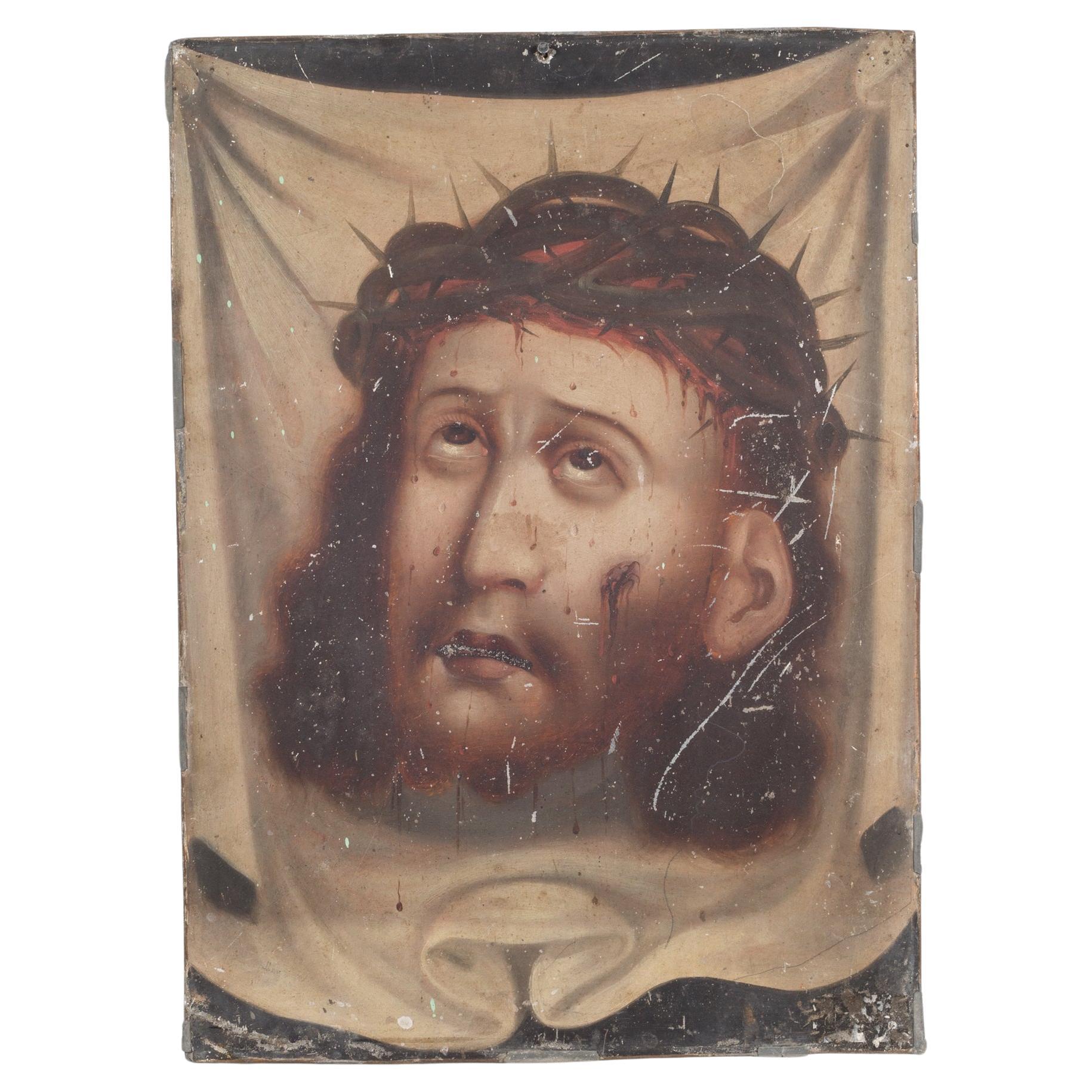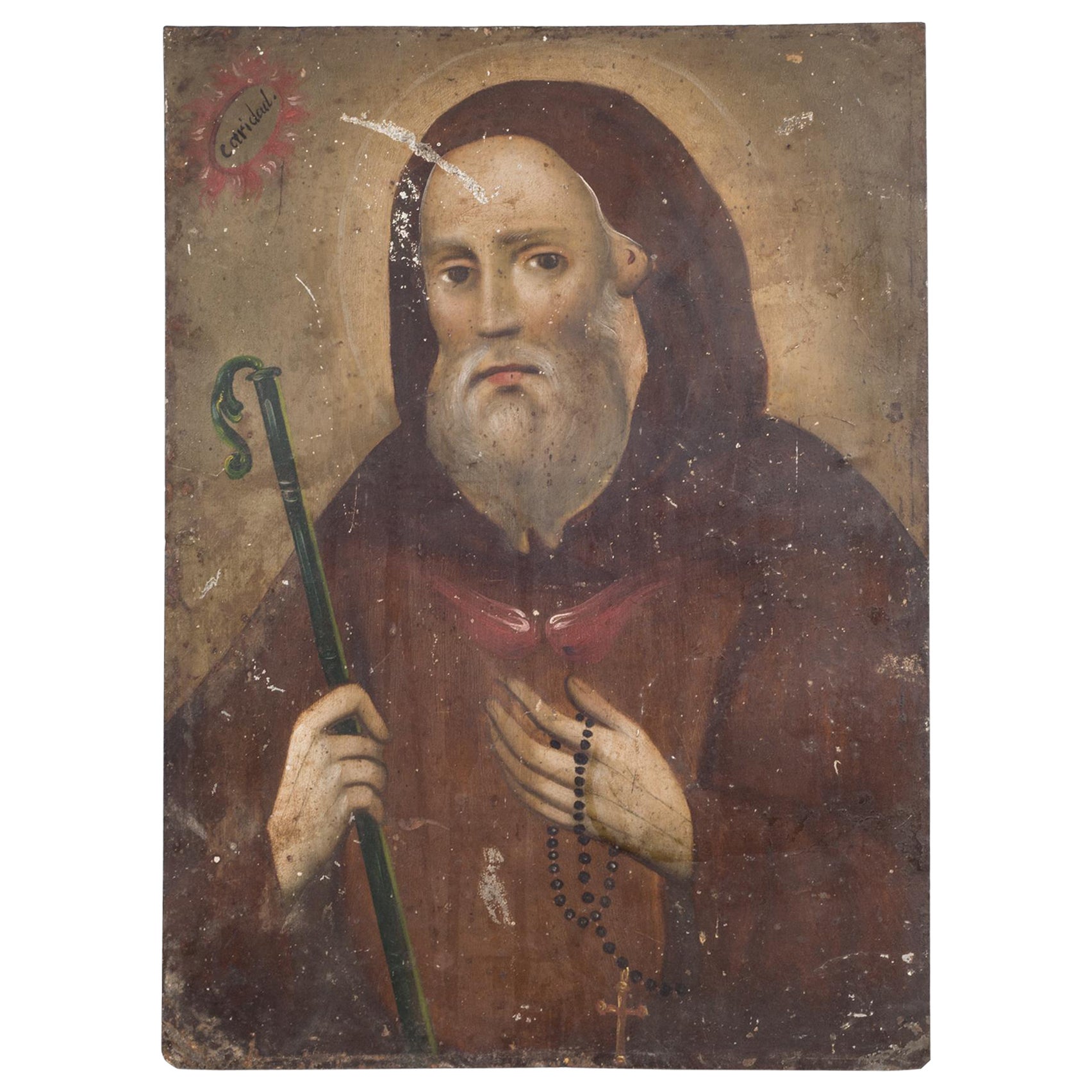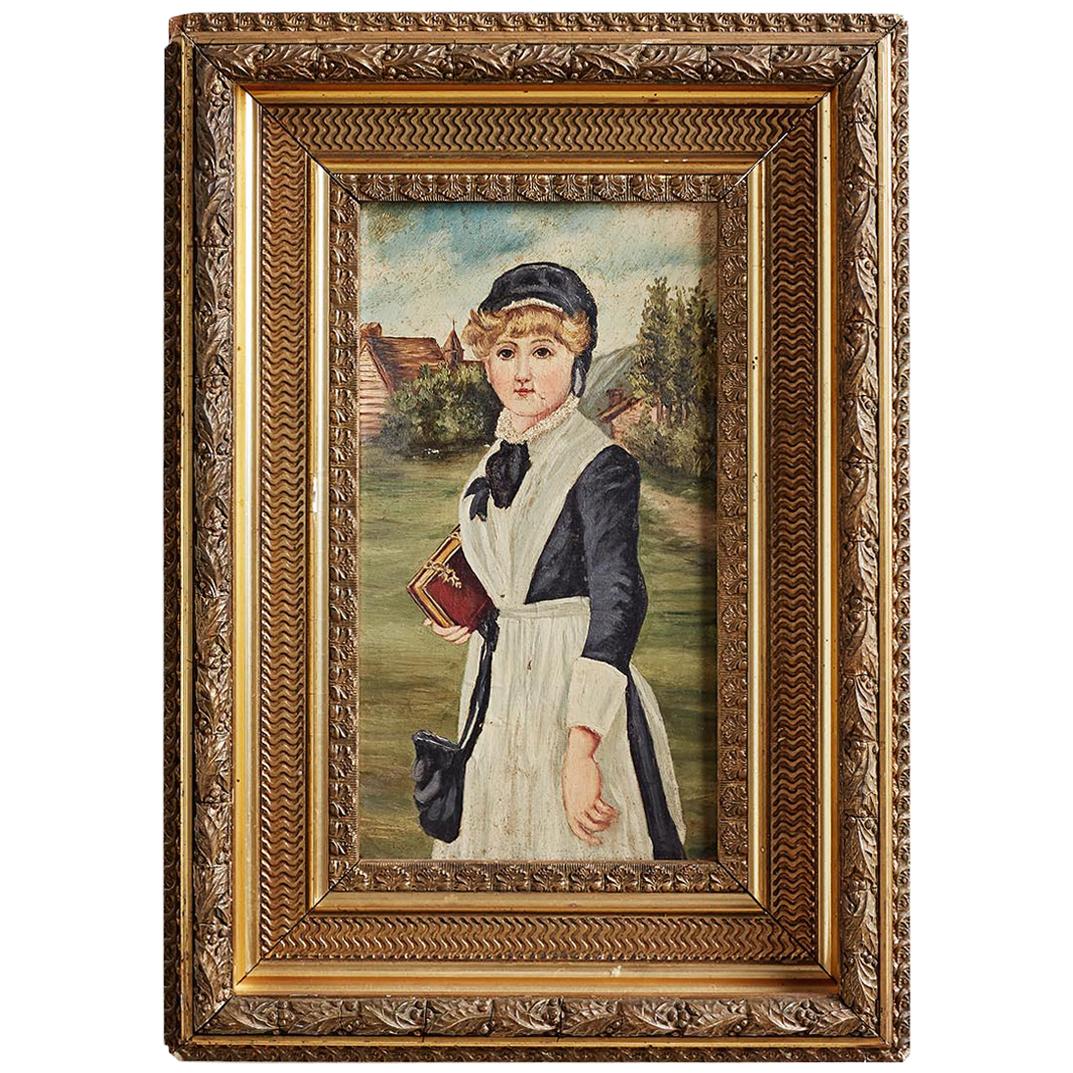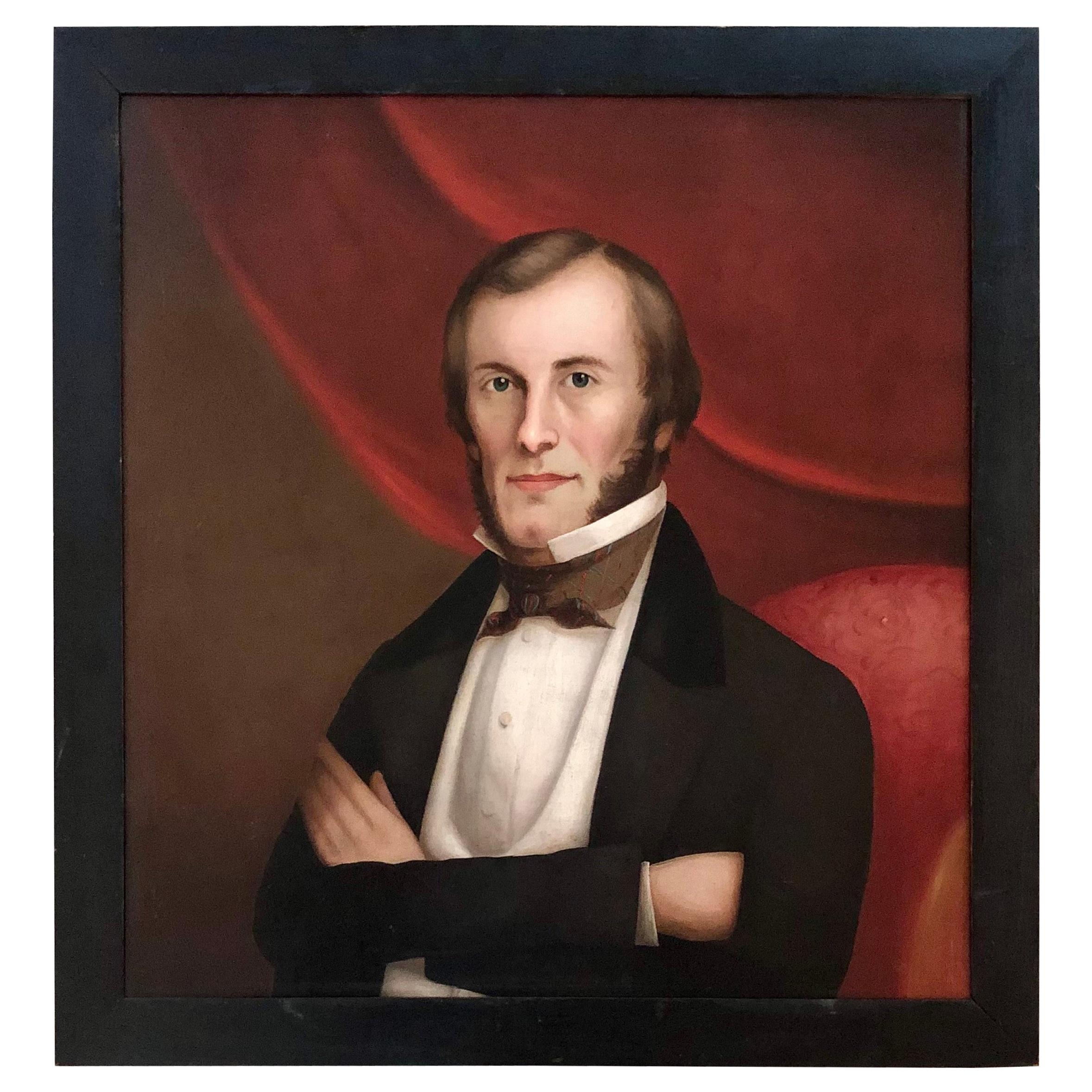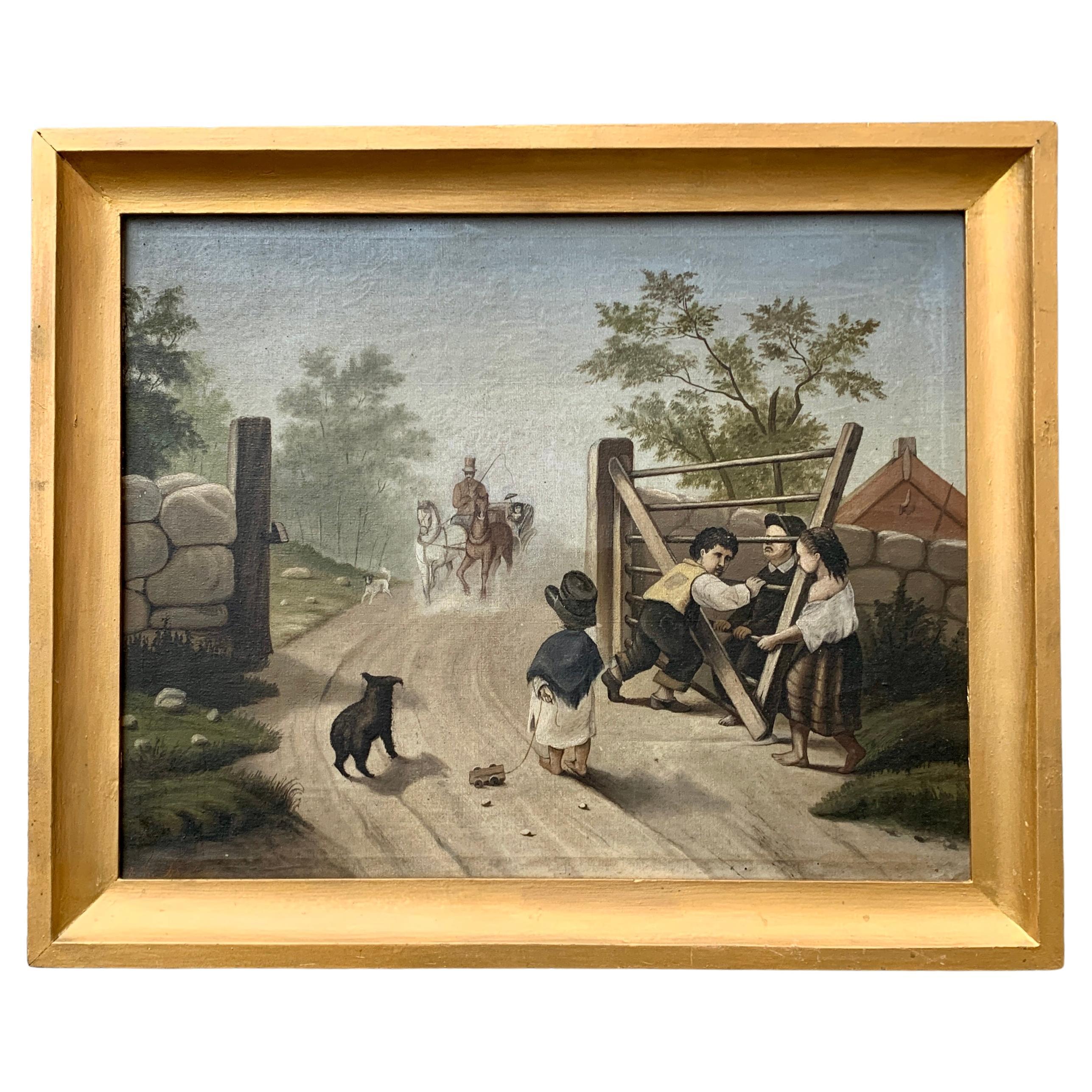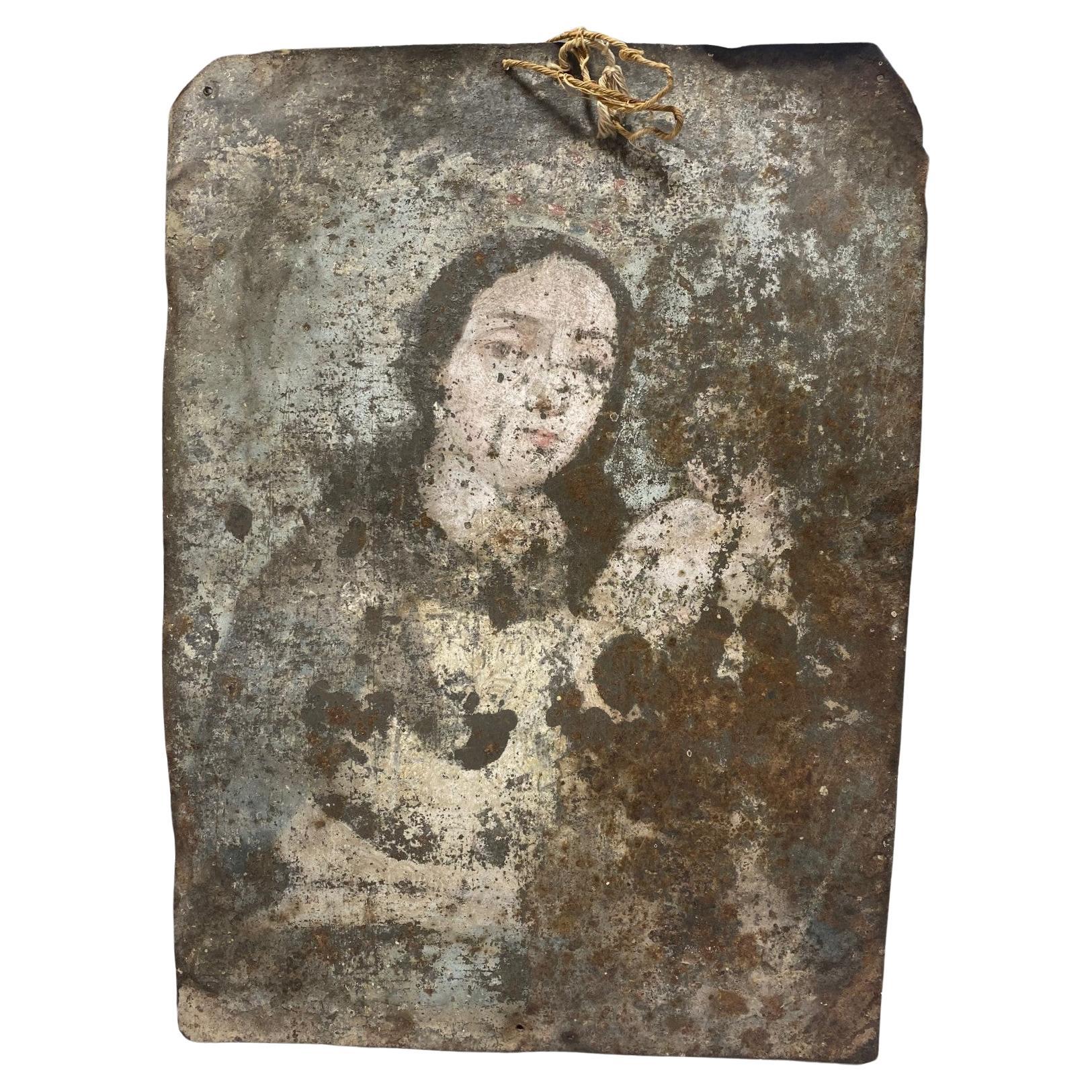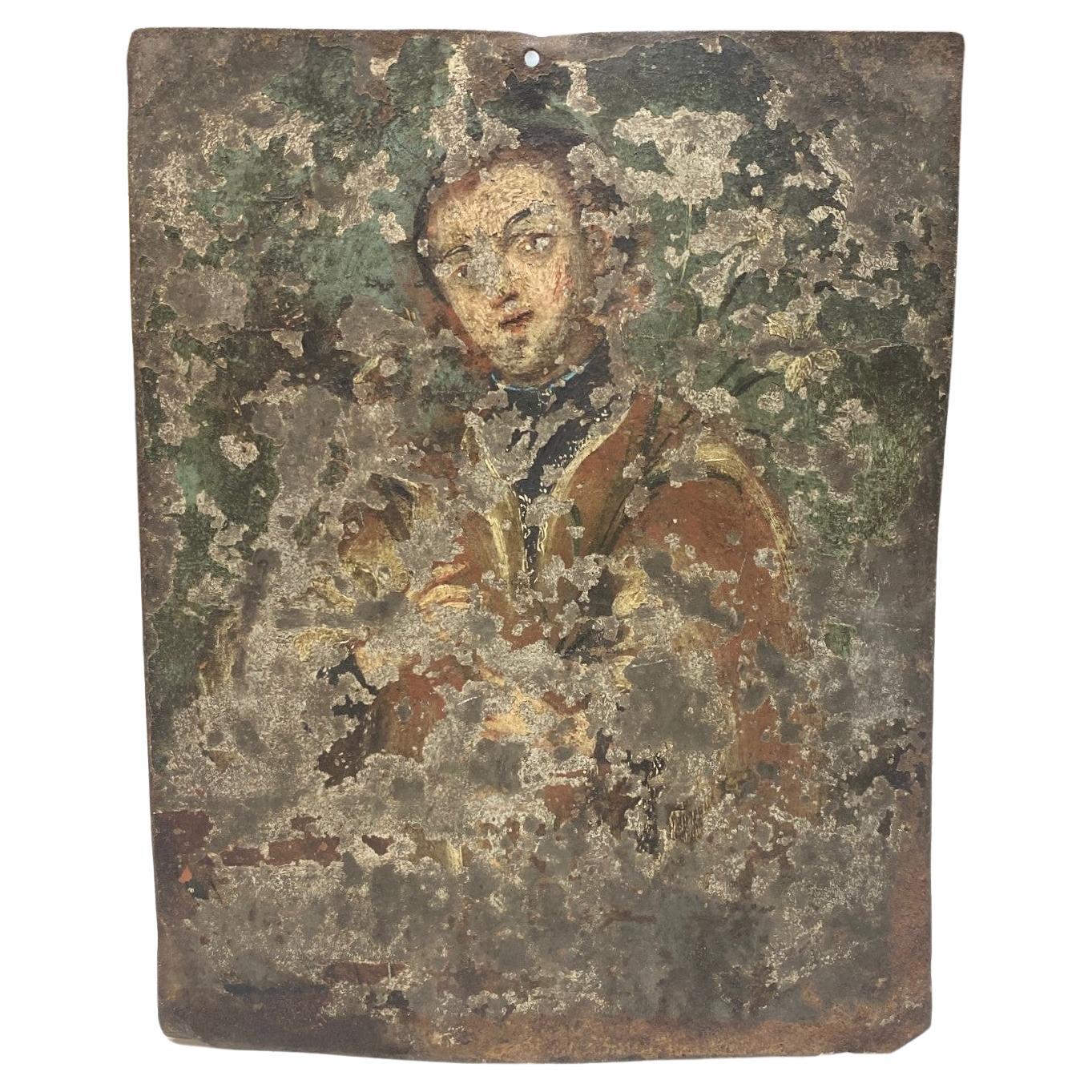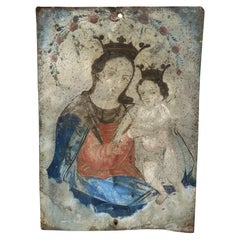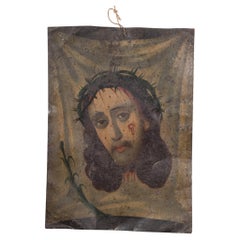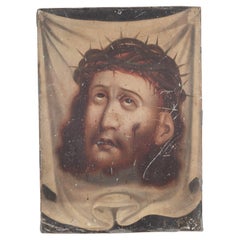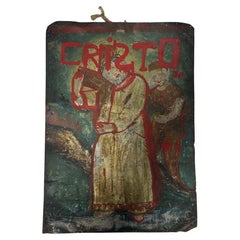
19th Century, Colonial Mexican Folk Art Retablo Devotional Painting of Christ
View Similar Items
Want more images or videos?
Request additional images or videos from the seller
1 of 13
19th Century, Colonial Mexican Folk Art Retablo Devotional Painting of Christ
About the Item
- Dimensions:Height: 14 in (35.56 cm)Width: 10 in (25.4 cm)Depth: 0.15 in (3.81 mm)
- Style:Folk Art (In the Style Of)
- Materials and Techniques:
- Place of Origin:
- Period:
- Date of Manufacture:1890s
- Condition:In very good vintage condition with wear consistent with age and use (please see photos). Beautiful and engaging overall.
- Seller Location:Studio City, CA
- Reference Number:1stDibs: LU2254331652742
About the Seller
4.9
Platinum Seller
These expertly vetted sellers are 1stDibs' most experienced sellers and are rated highest by our customers.
1stDibs seller since 2016
775 sales on 1stDibs
More From This SellerView All
- Colonial Mexican Folk Art Ex-Voto Retablo Painting of Mother Mary & Jesus, 1800sLocated in Studio City, CAA beautiful 19th-century Spanish Colonial Mexican Folk Art ex-voto retablo lámina painting featuring Mother Mary with the crowned infant Jesus Christ (standing on clouds) in her arms...Category
Antique 19th Century Mexican Folk Art Paintings
MaterialsMetal, Tin
- Colonial Mexican Folk Art Ex-Voto Retablo Painting of Mother Mary & Jesus, 1800sLocated in Studio City, CAA beautiful 19th-century Spanish Colonial Mexican Folk Art ex-voto retablo lámina painting featuring Mother Mary with the infant Jesus Christ (faded and now almost a ghost-like figur...Category
Antique 19th Century Mexican Folk Art Paintings
MaterialsMetal, Tin
- Spanish Colonial Mexican Folk Art Ex-Voto Retablo Painting Catholic Saint 1800sLocated in Studio City, CAA beautiful 19th-century Spanish Colonial Mexican Folk Art ex-voto retablo lámina painting featuring an unknown Spanish Roman Catholic Saint. The work is hand-painted on metal (li...Category
Antique 19th Century Mexican Folk Art Paintings
MaterialsMetal, Tin
- Colonial Mexican Folk Art Ex-Voto Retablo Painting of Santo Niño de Atocha 1800sLocated in Studio City, CAA beautiful 19th-century Spanish Colonial Mexican Folk Art ex-voto retablo lámina painting featuring Santo Niño de Atocha (also known as - Holy In...Category
Antique 19th Century Mexican Folk Art Paintings
MaterialsMetal, Tin
- Colonial Mexican Folk Art Ex-Voto Retablo Painting of Saint Rita De Cascia 1800sLocated in Studio City, CAA beautiful 19th century Spanish Colonial Mexican Folk Art ex-voto retablo lámina painting featuring Saint Rita De Cascia. Santa Rita is almost always depicted as she is here, with a trickle of blood and a thorn deeply embedded in her forehead. According to legend, in the year 1441, during a sermon on the Crown of Thorns, Santa Rita prayed so intently that a thorn detached itself from her crucifix and lodged itself in her forehead. For the next fifteen years, she bore this external sign of stigmatization and union with Christ. It was said her wound became so disturbing to view, that she spent the latter part of her life in isolation and prayer. At her canonization ceremony in the year 1900, Santa Rita de Cascia was bestowed the title of Patroness of Impossible Causes. In Mexico, Santa Rita is widely venerated as the Patroness Saint of mothers, abused wives, and heartbroken women. In this work, she is flanked by two small male figures representing her two beloved sons (notice the fine attention to the paintings of their faces and their glowing rosy red cheeks). She holds a large crucifix in one hand and a flagella whip, symbolizing her practice of mortifying the flesh, in her other hand. The work is hand painted on metal (likely tin). Ex-votos and retablos are often placed above the altars in churches or family shrines as votive offerings made in the form of religious pictures...Category
Antique 19th Century Mexican Folk Art Paintings
MaterialsMetal, Tin
- Black White Arizona Desert Mountain Landscape Signed Oil Painting, Edwin H HouseLocated in Studio City, CAA lovely gem of an impressionist Arizona landscape oil on board painting by Brisbee, Arizona artist Edwin H House. The painting is done in subtle s...Category
20th Century American Modern Paintings
MaterialsPaint
You May Also Like
- 19th C. Mexican Retablo, C.1880Located in San Francisco, CAABOUT An original 19th century Mexican folk retablo. Oil paint on tin. Subject unknown. CREATOR Unknown. DATE OF MANUFACTURE c.1880. MATERIALS AND TECHNIQUES Oil Paint on Tin. CONDITION Good. Wear consistent with age and use. DIMENSIONS H 14 in. W 10 in. HISTORY Retablos, better known as 'laminas' in Mexico, are small oil paintings on tin, wood and sometimes copper which were used in home altars to venerate the almost infinite number of Catholic saints. The literal translation for 'retablo' is 'behind the altar.' This unique genre of art, deeply rooted in European history, was brought to Mexico with the arrival of the Spanish and then ultimately adopted by New World mestizo natives to become what is known today as the Mexican folk retablo. The retablo was an art form that flourished in post conquest Mexico and then ultimately, with the introduction of inexpensive mediums such as tin, reached its pinnacle of popularity in the last quarter of the 19th century. With some exceptions, mostly untrained artists from the provinces worked to produce and reproduce these sacred images; some subjects painted more prolifically than others. A typical "retablero" may have reproduced the same image hundreds, if not thousands of times in his or her career. These oil paintings were sold to devout believers who displayed them in home altars to honor their patron saints. There are virtually hundreds of saints, each invoked to remedy a different situation. "San Ysidro Labrador," the patron saint of farmers, is venerated for good weather...Category
Antique 19th Century Mexican Folk Art Paintings
MaterialsTin
$1,395 Sale Price36% Off - 19th c. Mexican Retablo "Veronica's Veil" c.1880Located in San Francisco, CAABOUT An original 19th century Mexican folk retablo "Veronica's Veil" or "El Divono Rostro" in Spain . Oil paint on tin. The Veil of Veronica, known in Italian as the Volto Santo or Holy Face, is a Roman Catholic Relic which, according to legend, bears the likeness of the Face of Jesus that was imprinted on it prior to Jesus' crucifixion. According to Roman Catholicism, Saint Veronica encountered Jesus in Jeruselum on the way to Calvary. When she paused to wipe the sweat (Latin, suda) off his face with her veil, his image was left on the veil. In the small village of Osa de la Vega in Spain, there lived a couple who led a very pious life. They were Gregorio de la Torre and Isabel Corral. From their father, Juan Montilla, they inherited a picture of the Face of Jesus or the Divino Rostro. A story that is told one day, to the amazement of many who confirmed its veracity, the picture began to perspire with living blood. News of this extraordinary event spread swiftly and widely throughout the land. CREATOR Unknown. DATE OF MANUFACTURE c.1880. MATERIALS AND TECHNIQUES Oil Paint on Tin. CONDITION Good. Wear consistent with age and use. DIMENSIONS H 14 in. W 10 in. HISTORY Retablos, better known as 'laminas' in Mexico, are small oil paintings on tin, wood and sometimes copper which were used in home altars to venerate the almost infinite number of Catholic saints. The literal translation for 'retablo' is 'behind the altar.' This unique genre of art, deeply rooted in European history, was brought to Mexico with the arrival of the Spanish and then ultimately adopted by New World mestizo natives to become what is known today as the Mexican folk retablo. The retablo was an art form that flourished in post conquest Mexico and then ultimately, with the introduction of inexpensive mediums such as tin, reached its pinnacle of popularity in the last quarter of the 19th century. With some exceptions, mostly untrained artists from the provinces worked to produce and reproduce these sacred images; some subjects painted more prolifically than others. A typical "retablero" may have reproduced the same image hundreds, if not thousands of times in his or her career. These oil paintings were sold to devout believers who displayed them in home altars to honor their patron saints. There are virtually hundreds of saints, each invoked to remedy a different situation. "San Ysidro Labrador," the patron saint of farmers, is venerated for good weather...Category
Antique 19th Century Mexican Folk Art Paintings
MaterialsTin
- 19th C. Mexican Retablo "Veronica's Veil", c.1880Located in San Francisco, CAAbout An original 19th century Mexican folk retablo "Veronica's Veil" or "El Divono Rostro" in Spain . Oil paint on tin. The Veil of Veronica, known in Italian as the Volto Santo or Holy Face, is a Roman Catholic Relic which, according to legend, bears the likeness of the Face of Jesus that was imprinted on it prior to Jesus' crucifixion. According to Roman Catholicism, Saint Veronica encountered Jesus in Jeruselum on the way to Calvary. When she paused to wipe the sweat (Latin, suda) off his face with her veil, his image was left on the veil. In the small village of Osa de la Vega in Spain, there lived a couple who led a very pious life. They were Gregorio de la Torre and Isabel Corral. From their father, Juan Montilla, they inherited a picture of the Face of Jesus or the Divino Rostro. A story that is told one day, to the amazement of many who confirmed its veracity, the picture began to perspire with living blood. News of this extraordinary event spread swiftly and widely throughout the land. CREATOR Unknown. DATE OF MANUFACTURE c.1880. MATERIALS AND TECHNIQUES Oil Paint on Tin. CONDITION Good. Wear consistent with age and use. DIMENSIONS H 14 in. W 10 in. HISTORY Retablos, better known as 'laminas' in Mexico, are small oil paintings on tin, wood and sometimes copper which were used in home altars to venerate the almost infinite number of Catholic saints. The literal translation for 'retablo' is 'behind the altar.' This unique genre of art, deeply rooted in European history, was brought to Mexico with the arrival of the Spanish and then ultimately adopted by New World mestizo natives to become what is known today as the Mexican folk retablo. The retablo was an art form that flourished in post conquest Mexico and then ultimately, with the introduction of inexpensive mediums such as tin, reached its pinnacle of popularity in the last quarter of the 19th century. With some exceptions, mostly untrained artists from the provinces worked to produce and reproduce these sacred images; some subjects painted more prolifically than others. A typical "retablero" may have reproduced the same image hundreds, if not thousands of times in his or her career. These oil paintings were sold to devout believers who displayed them in home altars to honor their patron saints. There are virtually hundreds of saints, each invoked to remedy a different situation. "San Ysidro Labrador," the patron saint of farmers, is venerated for good weather...Category
Antique 19th Century Mexican Folk Art Paintings
MaterialsTin
- 19th C. Mexican Retablo Saint Francis c.1880Located in San Francisco, CAAbout An original 19th century Mexican folk retablo of Saint Francis. Oil paint on tin. St. Francis of Assisi, Italian San Francesco d’Assisi was born 1181-1182 in Assisi, duchy of Spoleto, Italy and died October 3, 1226. He was canonized July 16, 1228. He founded the Franciscan orders of the Friars Minor and the lay Third Order. He was also a leader of the movement of evangelical poverty in the early 13th century. His evangelical zeal, consecration to poverty, charity, and personal charisma drew thousands of followers. Francis’s devotion to the human Jesus and his desire to follow Jesus’ example reflected and reinforced important developments in medieval spirituality. Cretor Unknown. Date of manufacture c.1880. Materials and techniques Oil Paint on Tin. Condition Good. Wear consistent with age and use. Dimensions H 14 in. W 10 in. History Retablos, better known as 'laminas' in Mexico, are small oil paintings on tin, wood and sometimes copper which were used in home altars to venerate the almost infinite number of Catholic saints. The literal translation for 'retablo' is 'behind the altar.' This unique genre of art, deeply rooted in European history, was brought to Mexico with the arrival of the Spanish and then ultimately adopted by New World mestizo natives to become what is known today as the Mexican folk retablo. The retablo was an art form that flourished in post conquest Mexico and then ultimately, with the introduction of inexpensive mediums such as tin, reached its pinnacle of popularity in the last quarter of the 19th century. With some exceptions, mostly untrained artists from the provinces worked to produce and reproduce these sacred images; some subjects painted more prolifically than others. A typical "retablero" may have reproduced the same image hundreds, if not thousands of times in his or her career. These oil paintings were sold to devout believers who displayed them in home altars to honor their patron saints. There are virtually hundreds of saints, each invoked to remedy a different situation. "San Ysidro Labrador," the patron saint of farmers, is venerated for good weather...Category
Antique 19th Century Mexican Folk Art Paintings
MaterialsTin
- 19th Century Folk Art Painting of a Young GirlLocated in Rio Vista, CAInteresting 19th century Folk Art painting of a young girl holding a bible. Oil on canvas with a treed landscape and blue sky. Set in a deep carved giltwood frame with repeating bord...Category
Antique 19th Century European Folk Art Paintings
MaterialsCanvas, Wood
- 19th Century Folk Art Painting of a Gentleman Attributed to Horace BundyLocated in Wiscasset, MEOil on canvas, inscribed on the stretcher bar reverse. The painting is presented in a flat black frame that complements it well. Horace Bundy was an it...Category
Antique 1830s American Folk Art Paintings
MaterialsCanvas, Paint
$2,400 Sale Price38% Off
Recently Viewed
View AllMore Ways To Browse
Mexican Colonial Painting
Mexican Retablo
Retablos Mexico
Antique Retablos
Retablo Antique
Antique Retablo
Catholic Cross
Antique Catholic Cross
Antique Catholic Crosses
Christ Picture
Mexican Altar
Religious Retablos
Tin Retablo
Catholic Religious Paintings
Mexican Folk Art Church
Red Votive
Catholic Offering
Christian Altar


